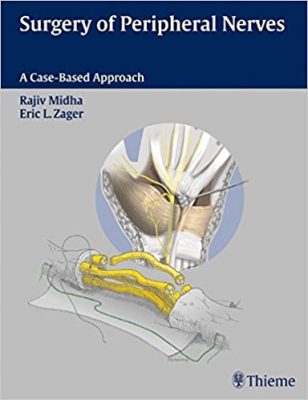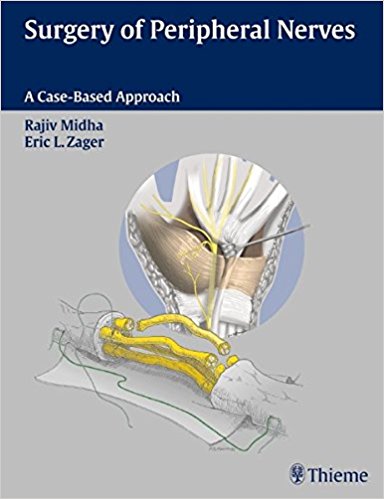 Editors: Rajiv Midha, MD; and Eric L. Zager, MD
Editors: Rajiv Midha, MD; and Eric L. Zager, MD
Publisher: Thieme – 288 pages
Book Review by: Nano Khilnani
This book is a concise text and reference source for topics associated with peripheral nerves.
Sixty-four specialists in neurosurgery, orthopedic surgery, plastic surgery, general surgery and internal medicine, from all over the United States and Canada, and five other countries – Australia, France, Germany, Saudi Arabia, and South Korea – authored the 57 chapters of this book. The contributors of content are physicians and surgeons, and professors at schools of medicine and medical centers.
The contents of this book are organized around four Sections:
- Section I. Brachial Plexus Injury and Entrapments
- Section II. Upper Extremity Peripheral Nerve Injuries and Entrapments
- Section III. Lower Extremity Peripheral Nerve Injuries and Entrapments
- Section IV. Nerve Tumors, Painful Nerve Conditions, and Miscellaneous Injuries
Let’s take a look at chapter 50 entitled Neurofibroma, authored by Dr. W. Bradley Jacobs and Dr. Rajiv Midha.
- Case Presentation
The case discussed in this chapter is that of a 34-year-old female with a known history of neurofibromatosis type 1 (NF1) presented to a neurosurgical clinic with a four-year history of pain in the right leg and a growing mass in the popliteal fossa.
She had previously undergone by a previous surgeon, a resection of several subcutaneous neurofibromas in the face and hand. “Dull” and “aching” were terms used by the patient in describing her pain located behind the knee, along with an intermittent sharper pain in the front of her calf into the ankle. Over the course of about a year, the patient noted that the lesion in the popliteal area had grown in size.
She has also had paresthesias occasionally and numbness in the dorsum of the foot along with mild weakness in her ankle movements. These neurological symptoms had been gradually progressive over the course of two years.
A physical exam revealed a healthy-looking pregnant woman with several café au lait spots and a number of small subcutaneous masses consistent with dermal neurofibromas. A sensory exam found decreased pinprick sensation over the dorsum of the right foot. The exam also found more profound hypoesthesia in the sural and tibial nerve distributions.
Magnetic resonance imaging (MRI) showed mass lesions involving the right sciatic nerve divisions in the popliteal region. These lesions were expanding the tibial and peroneal nerves in a plexiform fashion.
The masses had inhomegenous signal properties but enhanced homogenously with gadolinium and were consistent with plexiform neurofibromas. Five MR images shown (50-1, 50-2, and 50-3 (A,B,C) on pages 236-237 provide a lot of detail.
All three divisions of the sciatic nerve shown in 50-3(A) are abnormal with almost all fascicles enlarged by intraneural tumors. After electrical mapping of the tumor surface in 50-3 (B) it was decided that the dominant fascicle in the tibial nerve be dissected and removed. No attempt is made to remove the other less involved fascicles shown in 50-3 (C) to preserve nerve function after the operation.
Following the case presentation with diagnosis, discussion, and decision on the course of treatment (a surgical removal), below is the outline of the rest this chapter:
- Diagnosis
- Characteristic Clinical Presentation
- Neurofibromas Not Associated with NF1
- Neurofibromatosis Type 1- and Type 2-Associated Neurofibromas
- Differential Diagnosis
- Diagnostic Tests
- Management Options
- Outcome and Prognosis
- Pearls
- Pitfalls
- Suggested Readings
This book takes an extensive look at many subjects related to peripheral nerve surgery, with 57 chapters, too numerous to list in this book review. But the list of its four Sections given above provides you a sort of overview of the contents of this book.
This guide is an excellent source of authoritative information – in compact form in a single volume – on nerve injuries, nerve pain, nerve tumors, and other matters related to nerves, including management of nerve conditions, and treatment through surgery and/or other means.
Some important benefits of owning this book are:
- Case-based format thoroughly prepares the reader for managing various problems in the clinical setting
- Diagnostic guidelines and management strategies from leading experts in the field of peripheral nerve surgery enable clinicians to confidently handle each stage of patient care
- Pearls and pitfalls at the end of each chapter highlight critical aspects of treatment and are ideal for at-a-glance review prior to surgery
- More than 150 illustrations demonstrate key concepts
- Suggested readings with brief summaries provide valuable reviews of the literature
Editors:
Rajiv Midha, MD is Professor and Chief of Neurosurgery in the Department of Clinical Neurosciences at the University of Calgary at Foothills Medical Center in Calgary, Alberta, Canada.
Eric L. Zager, MD is Professor of Neurosurgery at the University of Pennsylvania School of Medicine in Philadelphia, Pennsylvania.







